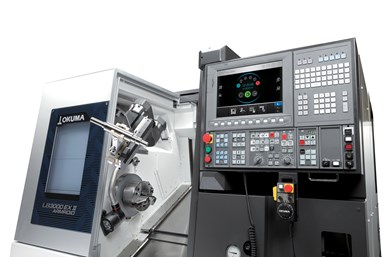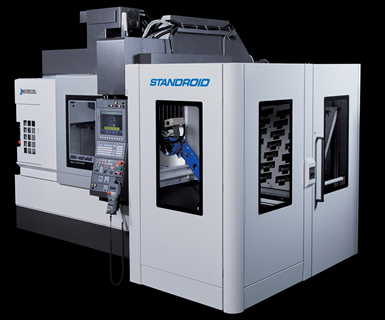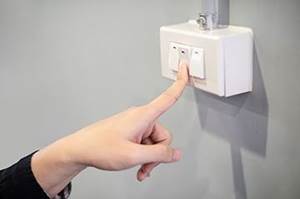Two of the biggest trends in the precision machining industry are currently automation and machining completed in one setup, in part due to the ongoing skilled worker shortage. So, wouldn’t it be stellar if those two trends were integrated into one CNC machine for those machine shops that need the consistency and less manpower that automation promises, and the time and money savings that multitasking machining delivers? Well, one machine tool OEM has developed such an offering and has made this efficient combination available on two of its CNC lathe models which are now available in the U.S.
Okuma America Corp. has packaged its Armroid robot within its LB3000 EX II horizontal lathe and the Multus B250II CNC multitasking machine, introducing an already integrated automation solution that comes with many benefits. Not only does the built-in robot design save space on the shop floor and enable easy portability but the Armroid also simplifies the operator’s job because the robot is both programmed and controlled through the company’s OSP machine control. Therefore, instead of learning two controls (one for the robot and one for the machine), understanding only one control is all that is necessary to run the system.
Armroid’s all-in-one design provides part loading and unloading, but also delivers in-process support in the machining workzone that conventional robots cannot provide. This includes chatter suppression, chip removal and in-machine cleaning.
Several Ways to Use It
Best suited for medium-batch production, according to Kevin Kraieski, senior applications engineer, Okuma America Corp., these flexible Armroid CNC lathes can be used with the robot and also without it as a standard machine. “The mobile stocker table can slide out of the way, and the Armroid can stay parked above the machining workzone,” he explains. “So, if you want to run two or three parts you can do that without the automation. You would set it up like a normal machine.”
Running a day shift with a human operator and a lights-out shift with the Armroid is another example of using the complete machine tool’s full functionality for a machine shop’s advantage. A robot can be on standby during the day while the operator handles small batches, performing part loading/unloading and other flexible jobs, and then automatic operations by the robot can be completed as a lights-out process.
Armroid’s all-in-one design provides part loading and unloading, but also delivers in-process support in the machining workzone that conventional robots cannot provide. This includes chatter suppression, chip removal and in-machine cleaning.
When human/robot collaboration is desired, the robot’s motion program automatically generates an optimal motion path by displaying the input start and endpoints and the parameters according to the guidance prompts on the OSP control panel.
Choosing the Optimal Equipment
Knowing whether shaft-type parts or chuck-type parts will be run on the Armroid CNC lathes is critical to choosing the most efficient workpiece stocker option for an application. Then, users can decide from a simple stocker with tilted racks, a pitch feed conveyor or a table-type flange stocker.
Once that option is chosen, there are different size stockers, explains David Fischer, product manager at Okuma. “For chucking parts, we have one stocker that has six stations,” he says. “And we are working on a 10-station unit to increase the number of parts you can have available. For shaft-type parts, Okuma offers several different stockers based on quantity and size range of parts.”
Next are options for the end effectors, which include a parallel workpiece hand for shaft part loading, a triple-grip workpiece hand for flange part loading, and a mixed blasting nozzle for coolant and air blasts that remove chips and clean the machining workzone while cutting. Workpiece support rollers that suppress chatter are also available.
Although Okuma offers grippers, a shop can choose to develop its own grippers for an application on the Armroid as an alternative.
Play it Safe, Keep it Simple
While Okuma furnishes many options on the Armroid that customizes it for an application, it also comes standard with features that are said to ensure safety and ease of use.
Unlike closed CNCs, Okuma’s OSP open-architecture control system provides a platform for customization and ongoing upgrades. Operators can download free third-party apps, add shortcuts to their preferred apps or even write their own app.
For the safety of the machine tool components and the operator, it is critical to verify that there will be no collisions within the system. Therefore, the Armroid is equipped with the manufacturer’s collision avoidance system to eliminate the chance of costly machine/robot crashes. The system’s pre-operation 3D simulation runs the real-time virtual application seconds ahead of the actual cutting, so the machine can be automatically stopped to prevent a collision.
The collision avoidance system shares data on the Armroid’s open-architecture OSP control that presents easy-to-use and convenient functionality. Unlike closed CNCs, the open-architecture control system provides a platform for customization and ongoing upgrades. Operators can download free third-party apps, add shortcuts to their preferred apps or even write their own app. The control includes an Application Program Interface that enables full read/write access to more than 6,000 machine data points.
Much like the Armroid, Okuma’s Standroid is also a standalone robot package. However, the Standroid, which is available on six of the company’s VMC models, is designed to handle larger parts because the robot is bigger.
Using the OSP-P300 control (which is standard on the Multus B250II CNC multitasking machine with Armroid) reduces setup times in several ways. For example, most work can be completed from one screen; an operational system can be created based on workflow; it is easy to connect to integrated factory floor and business communication channels; and convenient access to tooling lists/setup spreadsheets, process documents and other useful setup tools is available. This control can also be configured to email an operator or manager’s mobile phone when an alarm occurs.
Programming
Okuma and its distributors will train customers to be comfortable with the OSP control and the equipment. Kraieski explains that programming the Armroid is straightforward, especially when an operator is already familiar with Okuma machine tools. The menu layout for creating the files for the robot motion is similar to the company’s Advanced One-Touch processing system, he says.
The machine tool programming for a part can be done offline on a CAD/CAM system. Programming the robot is completed on the machine control by pulling up a file to create. “The Armroid needs to know where the part is to pick it up and where to drop it off,” Fischer explains. “And then that motion path in between is calculated by the Armroid using the collision avoidance software – the 3D models create a clear path through the machine.”
He adds that, with a conventional robot, the operator must teach the robot all these movements. Therefore, this process saves time by eliminating the need to manually teach the robot.
Lower Costs
The built-in design of the Armroid makes it a compact, flexible system with many benefits that equate to lower investment and running costs, and higher ROI. For instance, setup changes can be handled in-house without a robot integrator, which results in drastically less downtime and lower deployment costs.
Okuma America Corp. | 704-588-7000 | okuma.com
Related Content
Automation Breakthroughs Revolutionize Precision Machining for Complex Parts
Marubeni Citizen-Cincom delivers custom solutions to address some of the biggest challenges in precision machining from handling small parts, to robot integration and unique tooling needs.
Read More4 Bright Ideas for Effective Lights-Out Machining
Adopting lights-out machining involves considerations when a machine shop decides to move forward with the process. Here are some tips to a successful implementation.
Read MoreAutomation Idea for Halloween?
Maybe not. But, the candy-throwing robots at MetalQuest’s Nebraska facility do enable the contract machine shop to stand out at career fairs and similar events.
Read MoreAutomating Complete Workholding Changeovers for Turning
Robotic loading of all workholding elements is perhaps the next logical step to create fully automated yet flexible machining cells for CNC turning centers even when batch sizes are small.
Read MoreRead Next
How To (Better) Make a Micrometer
How does an inspection equipment manufacturer organize its factory floor? Join us as we explore the continuous improvement strategies and culture shifts The L.S. Starrett Co. is implementing across the over 500,000 square feet of its Athol, Massachusetts, headquarters.
Read MoreFinding the Right Tools for a Turning Shop
Xcelicut is a startup shop that has grown thanks to the right machines, cutting tools, grants and other resources.
Read More

















